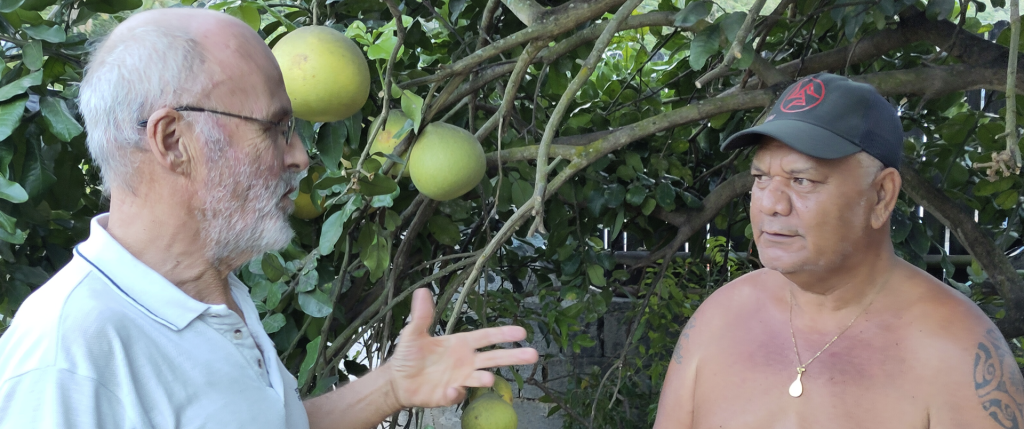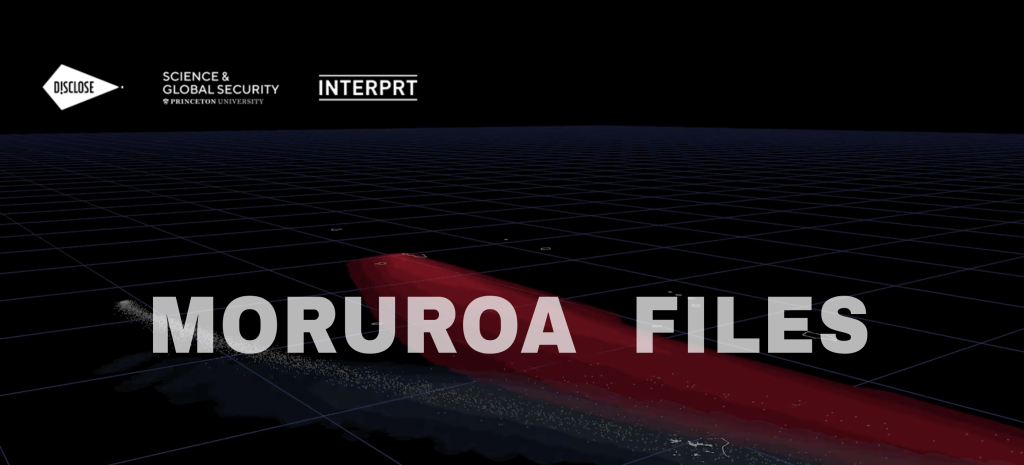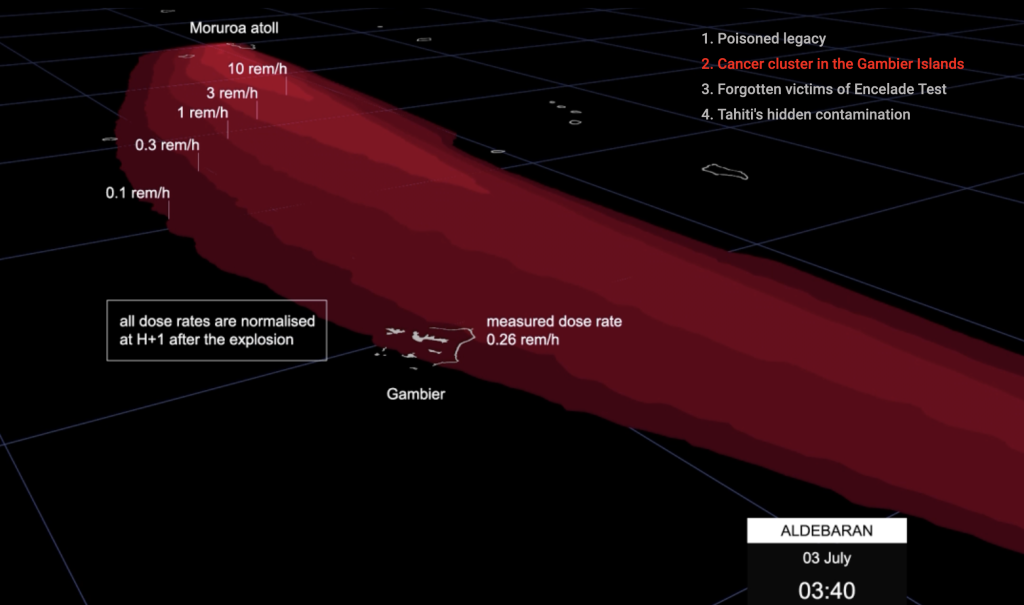We walked along the road on Mangareva, the main island of the Gambiers. Then we saw a great tree full of big beautiful grapefruits. They belong to Lucas, a Polynesian man of this island. He saw us and invited us to pick as much as we wanted. He showed us which ones were the best and under the tree we started to chat.

For whatever reason the subject came to the nuclear field tests on Moruroa. The French militaries started these tests in 1964. The first ones were from ships put near the island of Moruroa, and later from a balloon above it. Lucas was young then, but he remembered: “When I was about 5 years old, some french military came on the island. I remember the monings that a car with a big loudspeaker went up and down the road, ordering that all the inhabitants had to go into a shelter, it was some sort of concrete hall. We had to stay there for days.” This happened almost every time a nuclear test was about to happen.
He added: “and they said it was secret and nobody should tell anyone about it. Years later we learned it was because of some nuclear tests on an island near by.”
The impact
We asked if they noticed any changes. “Well, not directly. But later we noticed the chidren were often sick. They had go to the GP many times, as they had wounds and bruises which didnot not heal, or very slow. The doctor noted this on the ‘carenet medical’ the personal medical file of the child. But some years later the military came and they confiscated these papers, I think to hide any evidence ”
It is well known that the nucleair radiation of the first atmospheric tests were even measured in New Zealand. The distance from Moruroa is about 5000 kilometers away (compare: from Amsterdam to Abu Dhabi). After growing protests and political pressure, the French continued their tests underground.
“Sometimes they did not order to go into the shelter, but so now and then we thought there would be test going on”, Lucas continued. “As we saw a sort of extra tide going. You first could see the water receding from the beaches, the shores, then coming back. Very strange.”
The underground tests move the earth and that explains the ‘double tide’ described by Lucas.
In 1996, when the Cold War formally ended and the tests had to stop, the French military executed 193 tests.
Lucas continued his story: “ I lost my first brother when he was 26. And the second at the age of 35. They both died of cancer and they were not the only ones dying of cancer in Gambier.”
He also said: “I don’t know if it is also caused by nuclear radiation, but before we had so many sorts of fruits on the island, even lychee and mango’s. But they all disappeared. Now it is only grapefruits, bananas and cocos and that’s it.”
He concludes: “However, we told this story more often, but it is always covered up, put under the carpet.“
Wow, are these wild, crazy stories? Are there really many cancer cases here? Has it al been covered up indeed? What is true about this? We started investigating.

The French research
In 2020 the French INSERM (Institut National de la Sante et de la Recherche Medicale) executed an investigation at the request of the Ministry of Defence. They published the report “The health consequences of nuclear tests in French Polynesia”. According to this expertise, its authors felt that they could not “make a solid conclusion” to the existence of “links between the fallout from atmospheric nuclear tests and the occurrence of radiation-induced pathologies”. And the college of experts stressed the need to “refine the estimates of doses received by the local population and by civilian and military personnel”.
But no refinement of the estimates followed, nor any other investigation.
So far the French government.
An international research
From that point, in 2020 a collaboration of groups started researching. Disclose was a group of investigating journalists. The second was Interprt, a group of (nucleair and other) scientists. They worked in collaboration with the Princeton University. This big piece of research led to the description of the impact “(..) with the help of thousands of declassified military documents, hundreds of hours of calculations and computer simulations and dozens of unpublished testimonies, this investigation demonstrates for the first time the extent of the radioactive fallout that struck the inhabitants (..).”

Just to give an idea about the impact, the first paragraph tells: “Leukemia, lymphoma, cancer of the thyroid, lung, breast, stomach … In Polynesia, the experience of French nuclear tests is written in the flesh and blood of the inhabitants. Strontium has eaten into bones, cesium has eaten away at muscles and genitals, iodine has seeped into the thyroid.”
An article of this investigation is published in The Lancet (presuming you are not a member of the Lancet, you can read the abstract here.)
Here you can read the full investigation (a French and an English version): https://moruroa-files.org/en/investigation/moruroa-files .
The book -in French only- is called “TOXIQUE, enquete sur les essais nucleaires francais en Polynesie”.
Back to Lucas’ story
The investigators were confronted with a remarkable high cancer rate in Gambier, called the ‘Cancer Cluster in Gambier Islands’. A relation with the nuclear tests? The scientists worked the dispersion models of the nuclear particles in the air and ran various simulations. Here under, you find the most probable one. It explains the high rate of cancer cases in the Gambier Islands.

It looks like Lucas’ story is closer to reality then the story of the French government.

